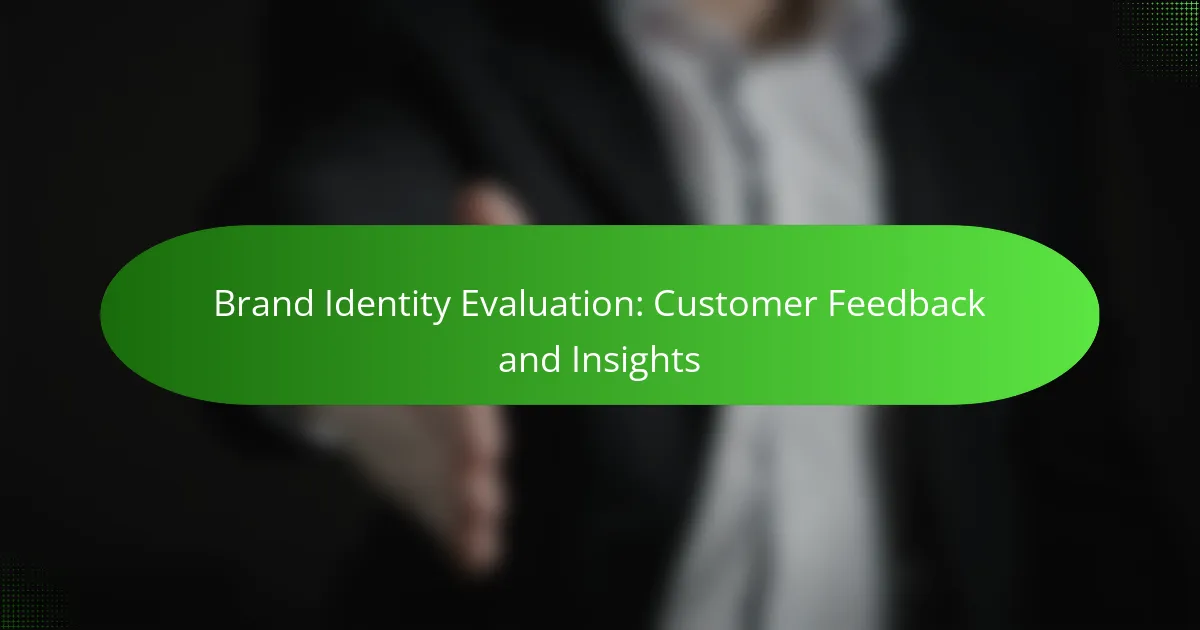Evaluating brand identity through customer feedback is crucial for understanding consumer perceptions and preferences. By employing various methods such as surveys and social media listening, brands can gain valuable insights that help align their identity with customer expectations. Utilizing specialized tools for gathering this feedback enhances the ability to refine and strengthen brand identity effectively.

How can customer feedback improve brand identity?
Customer feedback is essential for refining brand identity, as it provides insights into how consumers perceive a brand and what they value. By actively seeking and analyzing this feedback, brands can align their identity with customer expectations and preferences.
Enhances brand perception
Customer feedback directly influences brand perception by highlighting strengths and weaknesses. Positive feedback can reinforce a brand’s image, while negative comments can reveal misconceptions or areas of concern. Brands that listen and respond to feedback often see an improvement in how they are viewed in the marketplace.
For instance, a clothing brand that receives praise for its sustainable practices can leverage this feedback in its marketing, enhancing its reputation as an eco-friendly choice. This alignment can lead to increased visibility and attractiveness to environmentally conscious consumers.
Identifies areas for improvement
Customer feedback serves as a valuable tool for identifying specific areas where a brand can improve. By analyzing comments and suggestions, brands can pinpoint issues related to product quality, customer service, or user experience. This targeted approach allows for strategic enhancements that resonate with customers.
A restaurant, for example, might receive feedback about slow service during peak hours. By addressing this issue, such as by hiring additional staff or streamlining processes, the restaurant can enhance customer satisfaction and overall brand identity.
Strengthens customer loyalty
Actively engaging with customer feedback fosters a sense of loyalty among consumers. When customers see that their opinions are valued and acted upon, they are more likely to develop a strong emotional connection with the brand. This loyalty can translate into repeat business and positive word-of-mouth referrals.
Brands can strengthen this loyalty by implementing a feedback loop, where they not only collect feedback but also communicate changes made in response. For example, a tech company that updates its software based on user suggestions can create a community of loyal customers who feel invested in the brand’s success.

What methods are effective for gathering customer insights?
Effective methods for gathering customer insights include surveys, focus groups, and social media listening. Each method offers unique advantages and can provide valuable feedback on brand identity.
Surveys and questionnaires
Surveys and questionnaires are structured tools used to collect quantitative and qualitative data from customers. They can be distributed online or in person and often include multiple-choice questions, rating scales, and open-ended responses.
When designing surveys, keep them concise and focused to encourage higher response rates. Aim for a completion time of under 10 minutes and consider offering incentives, such as discounts or entry into a prize draw, to boost participation.
Focus groups
Focus groups involve small groups of customers discussing their perceptions and experiences related to a brand. This qualitative method allows for in-depth exploration of customer attitudes and can reveal insights that surveys may miss.
To conduct effective focus groups, select participants that represent your target audience and prepare a set of guiding questions. Ensure a skilled moderator leads the discussion to facilitate open dialogue and manage group dynamics.
Social media listening
Social media listening involves monitoring online conversations about your brand across various platforms. This method helps identify customer sentiments, trends, and feedback in real-time, providing a pulse on public perception.
Utilize social media analytics tools to track mentions, hashtags, and engagement metrics. Regularly analyze this data to adapt your brand strategy and address customer concerns promptly, enhancing overall brand identity.

What tools can assist in brand identity evaluation?
Several tools can effectively assist in brand identity evaluation by gathering customer feedback and insights. Utilizing platforms that specialize in surveys, social media analysis, and web analytics can provide a comprehensive view of how your brand is perceived by consumers.
Qualtrics for surveys
Qualtrics is a robust platform for creating and distributing surveys that can capture customer perceptions of your brand identity. It allows you to design tailored questionnaires that can assess brand awareness, loyalty, and overall sentiment.
When using Qualtrics, consider targeting specific demographics to gain deeper insights. For example, segmenting responses by age or location can reveal how different groups perceive your brand, helping you refine your identity accordingly.
Brandwatch for social insights
Brandwatch is a powerful tool for monitoring social media conversations about your brand. It analyzes mentions, sentiment, and trends across various platforms, providing valuable insights into how your brand is discussed online.
Utilizing Brandwatch can help you identify potential issues or positive feedback in real-time. For instance, tracking hashtags related to your brand can highlight customer sentiment and inform your marketing strategies.
Google Analytics for web feedback
Google Analytics offers essential insights into how users interact with your website, which is a critical aspect of brand identity evaluation. By analyzing metrics such as bounce rates, session duration, and user demographics, you can gauge the effectiveness of your branding efforts online.
To maximize Google Analytics, set up goals that align with your brand objectives, such as newsletter sign-ups or product purchases. This will allow you to measure how well your website reflects your brand identity and resonates with visitors.

How do you analyze customer feedback for brand identity?
Analyzing customer feedback for brand identity involves systematically gathering and interpreting insights to understand how your brand is perceived. This process helps identify strengths and weaknesses in your brand image, guiding strategic adjustments to align with customer expectations.
Thematic analysis
Thematic analysis focuses on identifying patterns and themes within customer feedback. By categorizing responses into common themes, you can pinpoint specific aspects of your brand identity that resonate with customers or require improvement.
To conduct a thematic analysis, start by collecting qualitative data from surveys, reviews, and social media comments. Use coding techniques to group similar feedback, which can reveal overarching themes such as quality, reliability, or customer service.
Sentiment analysis
Sentiment analysis evaluates the emotional tone behind customer feedback to gauge overall brand perception. This method uses natural language processing tools to classify feedback as positive, negative, or neutral, providing a quantitative measure of customer sentiment.
Implement sentiment analysis by utilizing software that can analyze large volumes of text data. This approach can help you quickly assess how customers feel about your brand and identify areas needing attention, such as negative sentiment spikes during specific campaigns.
Comparative analysis
Comparative analysis involves benchmarking your brand’s customer feedback against competitors or industry standards. This method helps you understand your brand’s position in the market and identify opportunities for differentiation.
To perform a comparative analysis, gather feedback data from your brand and competitors, focusing on key metrics like customer satisfaction and brand loyalty. This can reveal insights into how your brand identity stacks up against others, guiding strategic decisions to enhance your market presence.

What are the key metrics for evaluating brand identity?
Key metrics for evaluating brand identity include measures that assess customer perceptions and experiences with a brand. These metrics help businesses understand their strengths and weaknesses in the market, guiding strategic improvements.
Net Promoter Score (NPS)
Net Promoter Score (NPS) gauges customer loyalty by asking how likely customers are to recommend a brand to others. Responses are typically on a scale from 0 to 10, with scores of 9-10 indicating promoters, 7-8 as passives, and 0-6 as detractors.
A high NPS suggests strong brand loyalty, while a low score indicates potential issues. Businesses should aim for an NPS above 50, as this generally reflects a healthy brand perception. Regularly tracking NPS can help identify trends and areas for improvement.
Customer Satisfaction Score (CSAT)
Customer Satisfaction Score (CSAT) measures how satisfied customers are with a specific interaction or overall experience with a brand. This is often assessed through a simple survey question, such as “How satisfied were you with your experience?” on a scale from 1 to 5.
CSAT scores typically range from 70% to 90% for well-performing brands. To improve CSAT, businesses should focus on addressing customer feedback promptly and effectively. Regularly collecting and analyzing CSAT data can highlight service strengths and weaknesses, guiding enhancements in customer experience.
